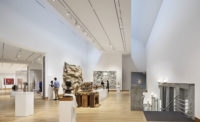Bowdoin College Museum of Art
Machado and Silvetti Associates chooses a dialectical, but not dissonant approach to adding onto the historic Bowdoin College Museum of Art in Brunswick, Maine.
Architects & Firms
Brunswick, Maine
The wisest architects are often ones who do not hang on too long to their first scheme. When they find obstacles in their path, they view annoying impediments merely as spurs for further creative action. Machado and Silvetti’s expansion of the Bowdoin College Museum of Art (formerly known as the Walker Art Building) offers an excellent case in point.
The graceful Renaissance Revival museum at Bowdoin College has long occupied a prime position on the leafy quad of a campus for 1750 students in Brunswick, Maine. Designed by Charles McKim, of McKim, Mead & White, in 1894, the elegantly symmetrical composition recalls Brunelleschi’s Pazzi Chapel (1430–61) in Florence while paying a bit of homage to Annibale Lippi’s Villa Medici (circa 1540) and Vignola’s Villa Giulia (1553) in Rome, as well. Indeed, the small brick-and-limestone palazzo prefigured the grander, marble Morgan Library McKim designed in 1906 in New York City. McKim’s architecture, so contained, so perfect, declares quite forthrightly the near impossibility of adding onto it. Yet the museum’s holdings of some 15,000 objects, including ancient art of the Mediterranean world, European old master drawings, and American paintings, necessitated expansion. In addition, the school needed teaching spaces and had to update its methods of climate control and security, as well as meet new standards for accessibility and construction safety.
To perform these tasks, Bowdoin turned to Machado and Silvetti Associates, a Boston-based firm. By all accounts, the choice made sense: The firm was in the midst of restoring and expanding the Getty Villa in Malibu [record, May 2006, page 106], where it integrated both Modernist and traditional elements without sacrificing the identity of each. (It should be noted, however, that the budget was vastly different— $275 million for the Getty Villa compared to Bowdoin’s $20.8 million.) Other architects considered for the Bowdoin project alternated between Modernists and traditionally minded—Polshek Partnership, Bruner/Cott & Associates, Robert A.M. Stern Architects, Hammond Beeby Rupert Ainge, and Schwartz/Silver Architects (which had helped in the initial feasibility studies). Even Tod Williams Billie Tsien Architects had previously consulted with the museum. During the discussions with the various teams, Katy Kline, the director of the museum, remarks, “Jorge Silvetti did such an extraordinary job analyzing the problems” that Bowdoin decided to go with his firm, jettisoning a second round of presentations.
But obstacles lay ahead. Originally Machado and Silvetti proposed a scheme that called for accessibility ramps feeding from the lawn into the museum through the lower level. While the architects had kept McKim’s front entrance, their scheme called for removing the grand staircase leading up to it. Among those who objected was the Maine Historic Preservation Commission’s director Earle Shettleworth. As he flatly declares, “This is Maine’s finest example of Renaissance Revival architecture, hands down, The grand staircase is a major character-defining feature.” Many in the college agreed, especially since commencement ceremonies take place on those steps. Although the trustees had approved the first scheme, Silvetti faced a battle.
PeopleArchitect Principal-in-charge: Consulting Principal: Project Director and Architect of Record: Project Architect: Senior Designers: Construction Administration Support: Project Team: Engineers: Structural Engineer: MEP/FP Engineers: Waterproofing/Building Envelope Engineers: Civil Engineer: Consultants: Landscape Architect: Lighting Design: Acoustical Consultants: Specifications: Van Deusen & Associates 198 Tremont Street Suite 443 Boston, MA 02116 tel: 888-503-3222 fax: 617-249-0790 Eric Tragash Security Consultant: Commissioning: General contractor: Photographers: Facundo de Zuviria Dan Gair Renderers: Software Used:
|
ProductsStructural Steel: Concrete: Exterior Cladding: Indiana Limestone: Brick: Exterior Naval Bronze Roof & Wall Panels: Exterior Invarimatte Stainless Steel Wall Panels: Structural Glass Curtainwall: Roofing: Entry Pavilion Roof Membrane: Bronze Roof Panels: Windows, Doors and Glazing: Structural Glass Curtainwalls: Gallery Skylights: Bronze Entry Door at Loggia: Custom Wood Doors: Fire-Control Doors: Loading Dock Rolling Door: Hardware: Closers Pulls Interior finishes: Suspension grid (admin offices): White Oak Cabinetwork and custom woodwork: Custom Steel Fabrication (Folded Plate Entry Stair, handrails): Paints and stains: White Oak Paneling: Floor and wall tile (bathrooms): Hardwood White Oak Floors: Limestone Bases and Baseboards (Assyrian Gallery): Lighting: Interior ambient lighting: Downlights: Exterior: Controls: Conveyance: Elevators: Glass Elevator Cab: Plumbing: Water Fountains: Toilets, Urinals and Lavatories: Valves: |




